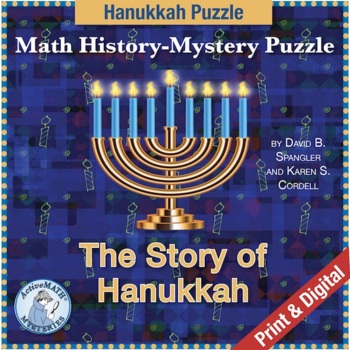Math & Holidays: The Story of Hanukkah / Chanukah | Mixed Review & Game
- PDF
- Easel Activity
Also included in
- This bundle of more than 140 PDF mini lessons related to people and events through the year. The interdisciplinary topics are springboards for middle school math review and test prep. These activities includes math clues for finding Mystery Years of events. Use in 6th, 7th, and 8th grades or high sPrice $99.95Original Price $193.00Save $93.05
- Integrate history with middle school math key concepts including problem solving. These PDF mini lessons for review or enrichment involve December holidays and events.Topics: Pearl Harbor, John Lennon, Hanukkah, Beethoven, Metric Conversion, Silent Night (Christmas), Louis Pasteur, Debbie Reynolds,Price $11.95Original Price $18.00Save $6.05
- To celebrate holidays in your middle school math class, try these PDF mini lessons that integrate math and history. There are fun holidays, legal holidays, and more!Fun Holidays: Groundhog Day (a freebie!), Valentine's Day, Pi Day, April fools' Day, Halloween Legal Holidays: Veterans Day, ThanksgiviPrice $10.95Original Price $20.50Save $9.55
Description
This activity connects math with Hanukkah (Chanukah). Clues for finding the Mystery Year involve patterns, probability & expected value, multiple percent discounts, and fraction operations in a real-world context. Other puzzles are available for holidays throughout the year.
Your PDF download includes:
- 3-page digital version with horizontal layout, prepped for Easel
- 2-page printable version
- 6 pages of Teacher Notes including step-by-step Solutions, Extensions, and a variety of Professional Development support.
- 1-page How to Use History-Mystery Puzzles
All Math History-Mystery Puzzles connect mathematics to history, inspirational individuals, current events, social justice issues, and pop culture. Click here for the free QUICK-REFERENCE LIST that shows the content domains and grade levels of over 135 puzzles for middle school and up. Save with the YEAR-LONG BUNDLE and you'll have a wide variety of review puzzles to use any time.
About the Writing Team: These research-based puzzles were written and designed by a highly-experienced instructional design team with many years of professional experience in mathematics education — both in teaching and in writing! To read more, see the "My Profile" tab just below the store banner.
Take a look at other puzzles by month or by subject, and CLICK TO FOLLOW THIS STORE to be notified of future puzzles and sales. Thanks for looking!









